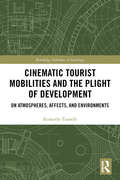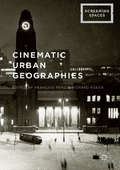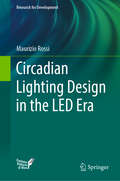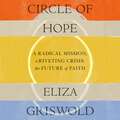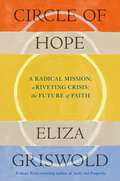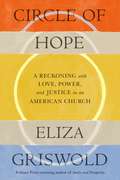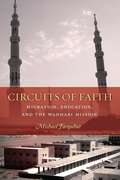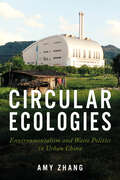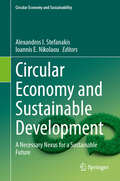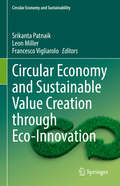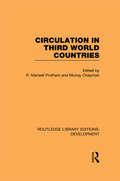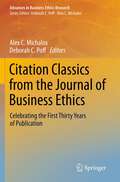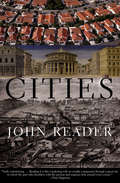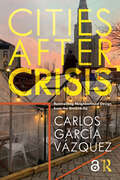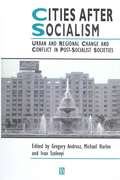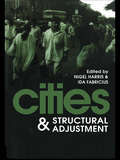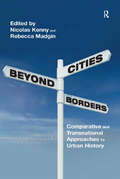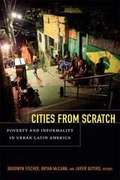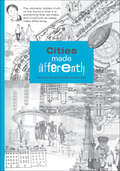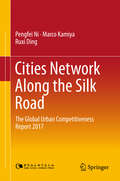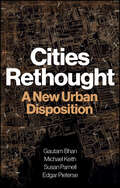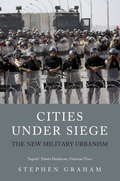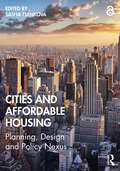- Table View
- List View
Cinematic Tourist Mobilities and the Plight of Development: On Atmospheres, Affects, and Environments (Routledge Advances in Sociology)
by Rodanthi TzanelliIt is said that movies have encroached upon social realities creating tourism enclaves based on distortions of history and heritage, or simulations that disregard both. What localities and nation-states value are discarded, suppressed, or modified beyond recognition in neoliberal markets; thus flattening out human experience, destroying natural habitats in the name of development, and putting the future of whole ecosystems at risk. Without disregarding such developmental risks Cinematic Tourist Mobilities and the Plight of Development explores how, en route to any beneficial or eco-destructive development, film tourist industries co-produce atmospheres of place and culture with tourists/film fans, local activists, and nation-states. Drawing on international examples of cinematically-induced tourism and tourismophobic activism, Tzanelli demonstrates how the allegedly unilateral industry-driven ‘design’ of location stands at a crossroads between political structures, systems of capitalist development, and resurgent localised agency. With an interdisciplinary methodological and epistemological portfolio connected to the new mobilities paradigm, this volume will appeal to scholars, students, and practitioners interested in tourism, migration, and urban studies in sociology, anthropology, geography, and international relations.
Cinematic Urban Geographies (Screening Spaces)
by Richard Koeck François PenzThis book proposes new methodological tools and approaches in order to tease out and elicit the different facets of urban fragmentation through the medium of cinema and the moving image, as a contribution to our understanding of cities and their topographies. In doing so it makes a significant contribution to the literature in the growing field of cartographic cinema and urban cinematics, by charting the many trajectories and points of contact between film and its topographical context. Under the influence of new technologies, the opening and the availability of previously unexplored archives but also the contribution of new scholars with novel approaches in addition to new work by experienced academics, Cinematic Urban Geographies demonstrates how we can reread the cinematic past with a view to construct the urban present and anticipate its future.
Circadian Lighting Design in the LED Era (Research for Development)
by Maurizio RossiThis book explores how lighting systems based on LED sources have the ability to positively influence the human circadian system, with benefits for health and well-being. The opening chapters examine the functioning of the human circadian system, its response to artificial lighting, potential health impacts of different types of light exposure, and current researches in circadian photometry. A first case study analyzes the natural lighting available in an urban interior, concluding that it is unable to activate the human circadian system over the entire year. Important original research is then described in which systems suitable for artificial circadian lighting in residential interiors and offices were developed after testing of new design paradigms based on LED sources. Readers will also find a detailed analysis of the LED products available or under development globally that may contribute to optimal artificial circadian lighting, as well as the environmental sensors, control interfaces, and monitoring systems suitable for integration with new LED lighting systems. Finally, guidelines for circadian lighting design are proposed, with identification of key requirements.
Circle of Hope: "extraordinary" - Patrick Radden Keefe
by Eliza GriswoldThe Pulitzer Prize winner's extraordinary portrait of one religious community - and what it means for us all"Lyrical, probing, and deeply reported, this is an extraordinary account ." ― Patrick Radden Keefe, author of Empire of Pain"Eliza Griswold is a dazzling reporter: ever observant, wise, sympathetic, and honest. And in this spellbinding book." ― David Grann, author of Killers of the Flower Moon and The Wager"A sharply contemporary book, painfully honest, stubbornly hopeful." ― Archbishop Rowan Williams, author of Passions of the Soul"That rarest of books: an examination of the sacred and spiritual realm captured with humor, humanity, and style."― Susan Orlean, author of On AnimalsAlthough most evangelicals have their sights firmly set on salvation in the afterlife, one extraordinary church in Philadelphia is designed to fight for progress and dedicated to social justice in this life. Over forty years, Circle of Hope grew from one family to four congregations battling for equality among the sexes, an end to racial discrimination, and offering hope to believers of all kinds - from outcasts to addicts - in its radical mission to improve the world.Then, rocked by many of the same issues facing society at large, from MeToo to Black Lives Matter, Circle of Hope is forced to confront its own mistakes, plunging the community into existential crisis.Building on years of deep reporting, Pulitzer Prize-winner Eliza Griswold paints an intimate portrait of pastors and church members' desperate wrestling to find a way to remain together despite their dividing truths.Through generational rifts, an increasingly politicised religious landscape, a pandemic and a rise in foundation-shaking activism, Circle of Hope tells a propulsive, layered story of what we do to stay true to our beliefs. It is a soaring, searing examination of what it means for a community to love, to grow, and crucially to disagree.
Circle of Hope: "extraordinary" - Patrick Radden Keefe
by Eliza GriswoldThe Pulitzer Prize winner's extraordinary portrait of one religious community - and what it means for us all"Lyrical, probing, and deeply reported, this is an extraordinary account ." ― Patrick Radden Keefe, author of Empire of Pain"Eliza Griswold is a dazzling reporter: ever observant, wise, sympathetic, and honest. And in this spellbinding book." ― David Grann, author of Killers of the Flower Moon and The Wager"A sharply contemporary book, painfully honest, stubbornly hopeful." ― Archbishop Rowan Williams, author of Passions of the Soul"That rarest of books: an examination of the sacred and spiritual realm captured with humor, humanity, and style."― Susan Orlean, author of On AnimalsAlthough most evangelicals have their sights firmly set on salvation in the afterlife, one extraordinary church in Philadelphia is designed to fight for progress and dedicated to social justice in this life. Over forty years, Circle of Hope grew from one family to four congregations battling for equality among the sexes, an end to racial discrimination, and offering hope to believers of all kinds - from outcasts to addicts - in its radical mission to improve the world.Then, rocked by many of the same issues facing society at large, from MeToo to Black Lives Matter, Circle of Hope is forced to confront its own mistakes, plunging the community into existential crisis.Building on years of deep reporting, Pulitzer Prize-winner Eliza Griswold paints an intimate portrait of pastors and church members' desperate wrestling to find a way to remain together despite their dividing truths.Through generational rifts, an increasingly politicised religious landscape, a pandemic and a rise in foundation-shaking activism, Circle of Hope tells a propulsive, layered story of what we do to stay true to our beliefs. It is a soaring, searing examination of what it means for a community to love, to grow, and crucially to disagree.
Circle of Hope: A Reckoning with Love, Power, and Justice in an American Church
by Eliza GriswoldA National Book Award FinalistNamed a Best Book of the Year by The New York Times, The Washington Post, The New Yorker, NPR, The Minnesota Star Tribune, and Publishers WeeklyOne of 100 Notable Books of 2024 at The New York TimesA Best Book of the Year: The New Yorker, Publishers Weekly, NPR and The Minnesota Star Tribune “Glows on every page . . . nearly miraculous.” —The Boston Globe “Marvelous.” —The New York Times From the Pulitzer Prize winner Eliza Griswold, Circle of Hope is an intimate portrait of a church, its radical mission, and its riveting crisis. “The revolution I wanted to be part of was in the church.” Americans have been leaving their churches. Some drift away. Some stay home. And some have been searching for—and finding—more authentic ways to find and follow Jesus. This is the story of one such “radical outpost of Jesus followers” dedicated to service, the Sermon on the Mount, and working toward justice for all in this life, not just salvation for some in the next. Part of a little-known yet influential movement at the edge of American evangelicalism, Philadelphia’s Circle of Hope grew for forty years, planted four congregations, and then found itself in crisis.The story that follows is an American allegory full of questions with urgent relevance for so many of us, not just the faithful: How do we commit to one another and our better selves in a fracturing world? Where does power live? Can it be shared? How do we make “the least of these” welcome?Building on years of deep reporting, the Pulitzer Prize winner Eliza Griswold has crafted an intimate, immersive, tenderhearted portrait of a community, as well as a riveting chronicle of its transformation, bearing witness to the ways a deeply committed membership and their team of devoted pastors are striving toward change that might help their church survive. Through generational rifts, an increasingly politicized religious landscape, a pandemic that prevented gathering to worship, and a rise in foundation-shaking activism, Circle of Hope tells a propulsive, layered story of what we do to stay true to our beliefs. It is a soaring, searing examination of what it means for us to love, to grow, and to disagree.
Circuits of Faith: Migration, Education, and the Wahhabi Mission
by Michael FarquharThe Islamic University of Medina was established by the Saudi state in 1961 to provide religious instruction primarily to foreign students. Students would come to Medina for religious education and were then expected to act as missionaries, promoting an understanding of Islam in line with the core tenets of Wahhabism. By the early 2000s, more than 11,000 young men from across the globe had graduated from the Islamic University. Circuits of Faith offers the first examination of the Islamic University and considers the efforts undertaken by Saudi actors and institutions to exert religious influence far beyond the kingdom's borders. Michael Farquhar draws on Arabic sources, including biographical materials, memoirs, syllabi, and back issues of the Islamic University journal, as well as interviews with former staff and students, to explore the institution's history and faculty, the content and style of instruction, and the trajectories and experiences of its students. Countering typical assumptions, Farquhar argues that the project undertaken through the Islamic University amounts to something more complex than just the one-way "export" of Wahhabism. Through transnational networks of students and faculty, this Saudi state-funded religious mission also relies upon, and has in turn been influenced by, far-reaching circulations of persons and ideas.
Circular Ecologies: Environmentalism and Waste Politics in Urban China
by Amy ZhangAfter four decades of reform and development, China is confronting a domestic waste crisis. As the world's largest waste-generating nation, the World Economic Forum projects that by 2030, the volume of household waste in China will be double that of the United States. Starting in the early 2000s, Chinese policymakers came to see waste management as an object of environmental governance central to the creation of "modern" cities, and experimented with the circular economy, in which technology and policy could convert all forms of waste back into resources. Based on long-term research in Guangzhou, Circular Ecologies critically analyzes the implementation of technologies and infrastructures to modernize a mega-city's waste management system, and the grassroots ecological politics that emerged in response. In Guangzhou, waste's transformation revealed uncomfortable truths about China's environmental governance: a preference for technology over labor, the aestheticization of order, and the expropriation of value in service of an ecological vision. Amy Zhang argues that in post-reform China, waste—the material vestige of decades of growth and increasing consumption—is a systemic irritant that troubles China's technocratic governance. Waste provoked an unlikely coalition of urban communities, from the middle class to precarious migrant workers, that came to constitute a nascent, bottom-up environmental politics, and offers a model for conceptualizing ecological action under authoritarian conditions.
Circular Economy and Sustainable Development: A Necessary Nexus for a Sustainable Future (Circular Economy and Sustainability)
by Alexandros I. Stefanakis Ioannis E. NikolaouThis book will highlight the role of CE in the sustainability field as it is expressed in the various fields and disciplines and its contribution to building a sustainable society by providing a better understanding of the relevant social and cultural structures and the need for cross-disciplinary knowledge and diverse skills. Such an integrated approach which combines the concept of sustainability in the engineering field to create a CE, has not yet been presented in detail in the published literature, and there are only scattered studies covering only small parts of this holistic approach. Hence, this book will represent a single reference that will provide summarized information and state-of-the-art knowledge on this topic of the future. The book will include chapters showcasing/investigating the relation between circular economy principles and their realization in different engineering fields. This includes theoretical justification, research studies and full-scale case studies. The approach focuses on two distinct levels: macro and micro, on both production and consumption sides.
Circular Economy and Sustainable Value Creation through Eco-Innovation (Circular Economy and Sustainability)
by Srikanta Patnaik Francesco Vigliarolo Leon MillerCircular economy and sustainable value creation through eco-innovation are interconnected concepts that revolve around creating a more sustainable and environmentally friendly approach to economic growth and business development. In a world confronted by pressing environmental challenges, the need for sustainable economic practices has never been more urgent. The traditional linear economic model, characterized by the "take-make-dispose" approach, has led to resource depletion, environmental degradation, and social inequalities. In response to these challenges, the concepts of circular economy and eco-innovation have emerged as powerful frameworks for reshaping our economic systems to prioritize sustainability. The circular economy represents a paradigm shift from the linear economic model that has dominated for centuries. Instead of viewing resources as finite and disposable, the circular economy embraces the idea that resources can be kept in circulation for as long as possible, thereby minimizing waste and environmental impact. At the core of the circular economy is the efficient use of resources. This entails reducing resource consumption, reusing products and materials, and recycling to extend the life of resources. Products are designed with durability and ease of repair in mind, ensuring they have a longer lifespan and can be easily maintained. Circular practices aim to restore natural systems and reduce harm to the environment, whether through reforestation, soil regeneration, or sustainable agriculture.
Circulation in Third World Countries (Routledge Library Editions: Development)
by R. Mansell Prothero Murray ChapmanCirculation is common in Third World countries and involves reciprocal flows of people, goods and ideas. The essays in this volume, first published in1985, discuss concepts associated with circulation in its various forms, and they present empirical evidence based on field work from holistic, ecological, social, and economic points of view. Contributions from Latin America, the Caribbean, Africa, Asia and the Pacific come from an international group of authors representing a variety of disciplines in the social sciences. All who are concerned with social and economic development need to recognise the importance of circulation at all levels of society and polity.
Citation Classics from the Journal of Business Ethics: Celebrating the First Thirty Years of Publication (Advances in Business Ethics Research #2)
by Alex C. Michalos Deborah C PoffThe Journal of Business Ethics was founded by Alex C. Michalos and Deborah C. Poff and published its first issue in March 1982. It is the most frequently cited business ethics journal in the world. The Journal has always offered a multi-disciplinary and international public forum for the discussion of issues concerning the interaction of successful business and moral virtue. Its authors and readers are primarily scholars and students in social sciences and philosophy , with special interests in the interaction of these disciplines with business or corporate responsibility. Since the field of business ethics grew simultaneously with the growth of the Journal, a collection of its most cited articles is tantamount to a collection of the articles that had the greatest influence in defining the field over its first 30 years of development. In this anniversary volume, an overview of citation classics from the Journal is presented, the 33 most frequently cited articles are reproduced and brief reflections on the impact of the Journal on the field are given from over 100 scholars who authored citation classics and/or distinguished papers, as well as those who served on the Editorial Board and/or are recognized as leaders in the field.
Cities
by John ReaderIn Cities, the acclaimed historian John Reader takes us on a journey of the city-from its earliest example in the Ancient Near East to today’s teeming centers of compressed existence, such as Mumbai and Tokyo. Cities are home to half the planet’s population and consume nearly three-quarters of its natural resources. For Reader, they are our most natural artifacts, the civic spirit of our collective ingenuity. He gives us the ecological and functional context of how cities evolved throughout human history-the connection between pottery making and childbirth in ancient Anatolia, plumbing and politics in ancient Rome, and revolution and street planning in nineteenth-century Paris. This illuminating study helps us to understand how urban centers thrive, decline, and rise again-and prepares us for the role cities will play in the future.
Cities After Crisis: Reinventing Neighborhood Design from the Ground-Up
by Carlos Garcia VazquezCities After Crisis shows how urbanism and urban design is redefining cities after the global health, economic, and environmental crises of the past decades. The book details how these crises have led to a new urban vision—from avantgarde modern design to an artisan aesthetic that calls for simplicity and the everyday, from the sustainable development paradigm to a resilient vision that defends de-growth and the re-wilding of cities, from a homogenizing globalism to a new localism that values what is distinctive and nearby, from the privatization of the public realm to the commoning and self-governance of urban resources, and from top-down to bottom-up processes based on the engagement and empowerment of communities. Through examples from cities around the world and a detailed look at the London neighbourhood of Dalston, the book shows designers and planners how to incorporate residents into the decision-making process, design inclusive public spaces that can be permanently reconfigured, reimagine obsolete spaces to accommodate radically contemporary uses, and build gardens designed and maintained by the community, among other projects.
Cities After Socialism: Urban and Regional Change and Conflict in Post-Socialist Societies (IJURR Studies in Urban and Social Change Book Series)
by Ivan Szelenyi Michael Harloe Gregory AndruszCities After Socialism is the first substantial and authoritative analysis of the role of cities in the transition to capitalism that is occurring in the former communist states of Easter Europe and the Soviet Union. It will be of equal value to urban specialists and to those who have a more general interest in the most dramatic socio-political event of the contemporary era - the collapse of state socialism. Written by an international group of leading experts in the field, Cities after socialism asks and answers some crucial questions about the nature of the emergent post-socialist urban system and the conflicts and inequalities which are being generated by the processes of change now occurring.
Cities And Structural Adjustment
by Nigel Harris Ida FabriciusThis work addresses the challenge faced in the management of major cities throughout the world as they adjust to economic reform and, in particular, to becoming more open to the processes operating in worldwide markets. Such processes have already had some dramatic effects on large cities in developed and developing countries - the rapid decline in manufacturing in older industrial cities and the emergence of the servicing city are but two of the more striking outcomes. Based on substantial case studies of cities in the developed and the developing world - Sheffield, Barcelona, Lille, Mexico City, Monterrey, Santiago de Chile, Bogota, Kingston Jamaica and Johannesburg - themes are drawn out, extending from structural economic change to policy reactions, new city initiatives, management, planning and finance.
Cities Beyond Borders: Comparative and Transnational Approaches to Urban History
by Nicolas Kenny Rebecca MadginDrawing on a body of research covering primarily Europe and the Americas, but stretching also to Asia and Africa, from the mid-eighteenth century to the present, this book explores the methodological and heuristic implications of studying cities in relation to one another. Moving fluidly between comparative and transnational methods, as well as across regional and national lines, the contributors to this volume demonstrate the necessity of this broader view in assessing not just the fundamentals of urban life, the way cities are occupied and organised on a daily basis, but also the urban mindscape, the way cities are imagined and represented. In doing so the volume provides valuable insights into the advantages and limitations of using multiple cities to form historical inquiries.
Cities From Scratch: Poverty and Informality in Urban Latin America
by Javier Auyero Bryan Mccann Brodwyn FischerThis collection of essays challenges long-entrenched ideas about the history, nature, and significance of the informal neighborhoods that house the vast majority of Latin America's urban poor. Until recently, scholars have mainly viewed these settlements through the prisms of crime and drug-related violence, modernization and development theories, populist or revolutionary politics, or debates about the cultures of poverty. Yet shantytowns have proven both more durable and more multifaceted than any of these perspectives foresaw. Far from being accidental offshoots of more dynamic economic and political developments, they are now a permanent and integral part of Latin America's urban societies, critical to struggles over democratization, economic transformation, identity politics, and the drug and arms trades. Integrating historical, cultural, and social scientific methodologies, this collection brings together recent research from across Latin America, from the informal neighborhoods of Rio de Janeiro and Mexico City, Managua and Buenos Aires. Amid alarmist exposés, Cities from Scratch intervenes by considering Latin American shantytowns at a new level of interdisciplinary complexity.Contributors. Javier Auyero, Mariana Cavalcanti, Ratão Diniz, Emilio Duhau, Sujatha Fernandes, Brodwyn Fischer, Bryan McCann, Edward Murphy, Dennis Rodgers
Cities Made Differently
by David Graeber Nika DubrovskyFull of playful graphics, provocative questions, and curious facts, this book asks what makes a city and how we might make them differently.What makes a city a city? Who says? Drafted over decades out of a dialogue between artist and author Nika Dubrovsky, the late anthropologist David Graeber, and Nika&’s then four-year-old son, this delightful and provocative book Cities Made Differently opens a space for invention and collaboration. Fusing anthropology, literature, play, and drawing, the book is essentially a visual essay that asks us to reconsider our ideas about cities and the people who inhabit them. Drawing us into a world of history and myth, science and imagination, Graeber and Dubrovsky invite us to rethink the worlds we inhabit—because we can, and nothing is too strange or too wonderful to be true.With inspired pictures and prompts, Cities Made Differently asks what a city is, or could be, or once was. Sleeping at the bottom of the ocean? Buried in lava? What were those cities of long ago, and what will the cities of the future be? They might be virtual, ruled by AI, or islands of beautiful architecture afloat in seas of greenery. They might be utopian places of refuge or refugee camps as far as the eye can see. On land, underground or aloft, excavated or imagined, cities, this book tells us in provocative and funny ways, can be anything we want them to be—and what we want them to be can tell us something about who we are, what it is to be human, and what&’s possible when we make way for wonder.Cities Made Differently exists in two versions, one for reading and thinking, the other, downloadable at a4kids.org, for drawing and dreaming.
Cities Network Along the Silk Road: The Global Urban Competitiveness Report 2017
by Pengfei Ni Marco Kamiya Ruxi DingBy empirically assessing the competitiveness of 505 cities around the world from regional, national and other perspectives, this book not only ranks these cities but also presents a treasure trove of information with regard to each city's relative strengths and weaknesses. This unique resource draws on a wealth of data sources, all of which are described and assessed, and involve urban economics, geography, regional economics and many other fields. Using a concise indexing system, sophisticated methodology, and extensive figures and tables, it provides a comprehensive analysis of global urban competitiveness in 2015. Given the scope of its coverage, the book will be of great interest to readers such as local authorities, decision-makers and economic planners in cities throughout the world.
Cities Rethought: A New Urban Disposition
by Susan Parnell Gautam Bhan Michael Keith Edgar PieterseIn a world of disruptions and seemingly endless complexity, cities have become central to thinking about the future of humanity. Yet the study of cities is fragmented among different silos of expertise, diverse genres of scholarship, and widening chasms between theory and practice. How can we do better? Cities Rethought suggests that we need to remake the way we see and know cities in order to rethink how we act and intervene within them. To this end, it offers the contours of a new urban disposition. Its normative, analytical, and operational elements offer an opportunity for scholars, practitioners, and citizens alike to approach the complexity of cities anew. Written collectively for a wide audience, the text draws from cities across the global north and south, speaks across diverse genres of ideas, and reflects on the lived experience of the authors as both researchers and practitioners. It is an essential text for anyone committed to knowing their own cities as well as finding ways to meaningfully intervene in them.
Cities Surround the Countryside: Urban Aesthetics in Postsocialist China
by Robin VisserDenounced as parasitical under Chairman Mao and devalued by the norms of traditional Chinese ethics, the city now functions as a site of individual and collective identity in China. Cities envelop the countryside, not only geographically and demographically but also in terms of cultural impact. Robin Visser illuminates the cultural dynamics of three decades of radical urban development in China. Interpreting fiction, cinema, visual art, architecture, and urban design, she analyzes how the aesthetics of the urban environment have shaped the emotions and behavior of people and cultures, and how individual and collective images of and practices in the city have produced urban aesthetics. By relating the built environment to culture, Visser situates postsocialist Chinese urban aesthetics within local and global economic and intellectual trends. In the 1980s, writers, filmmakers, and artists began to probe the contradictions in China's urbanization policies and rhetoric. Powerful neorealist fiction, cinema, documentaries, paintings, photographs, performances, and installations contrasted forms of glittering urban renewal with the government's inattention to a livable urban infrastructure. Narratives and images depicting the melancholy urban subject came to illustrate ethical quandaries raised by urban life. Visser relates her analysis of this art to major transformations in urban planning under global neoliberalism, to the development of cultural studies in the Chinese academy, and to ways that specific cities, particularly Beijing and Shanghai, figure in the cultural imagination. Despite the environmental and cultural destruction caused by China's neoliberal policies, Visser argues for the emergence of a new urban self-awareness, one that offers creative resolutions for the dilemmas of urbanism through new forms of intellectual engagement in society and nascent forms of civic governance.
Cities Under Siege: The New Military Urbanism
by Stephen GrahamCities are the new battleground of our increasingly urban world. From the slums of the global South to the wealthy financial centers of the West, Cities Under Siege traces the spread of political violence through the sites, spaces, infrastructure and symbols of the world's rapidly expanding metropolitan areas.Drawing on a wealth of original research, Stephen Graham shows how Western militaries and security forces now perceive all urban terrain as a conflict zone inhabited by lurking shadow enemies. Urban inhabitants have become targets that need to be continually tracked, scanned and controlled. Graham examines the transformation of Western armies into high-tech urban counter-insurgency forces. He looks at the militarization and surveillance of international borders, the use of 'security' concerns to suppress democratic dissent, and the enacting of legislation to suspend civilian law. In doing so, he reveals how the New Military Urbanism permeates the entire fabric of urban life, from subway and transport networks hardwired with high-tech 'command and control' systems to the insidious militarization of a popular culture corrupted by the all-pervasive discourse of 'terrorism.'
Cities and Affordable Housing: Planning, Design and Policy Nexus
by Sasha TsenkovaThis book provides a comparative perspective on housing and planning policies affecting the future of cities, focusing on people- and place-based outcomes using the nexus of planning, design and policy. A rich mosaic of case studies features good practices of city-led strategies for affordable housing provision, as well as individual projects capitalising on partnerships to build mixed-income housing and revitalise neighbourhoods. Twenty chapters provide unique perspectives on diversity of approaches in eight countries and 12 cities in Europe, Canada and the USA. Combining academic rigour with knowledge from critical practice, the book uses robust empirical analysis and evidence-based case study research to illustrate the potential of affordable housing partnerships for mixed-income, socially inclusive neighbourhoods as a model to rebuild cities. Cities and Affordable Housing is an essential interdisciplinary collection on planning and design that will be of great interest to scholars, urban professionals, architects, planners and policy-makers interested in housing, urban planning and city building.
Cities and Agriculture: Developing Resilient Urban Food Systems (Earthscan Food and Agriculture)
by Pay Drechsel Henk De ZeeuwAs people increasingly migrate to urban settings and more than half of the world's population now lives in cities, it is vital to plan and provide for sustainable and resilient food systems which reflect this challenge. This volume presents experience and evidence-based "state of the art" chapters on the key dimensions of urban food challenges and types of intra- and peri-urban agriculture. The book provides urban planners, local policy makers and urban development practitioners with an overview of crucial aspects of urban food systems based on an up to date review of research results and practical experiences in both developed and developing countries. By doing so, the international team of authors provides a balanced textbook for students of the growing number of courses on sustainable agriculture, food and urban studies, as well as a solid basis for well-informed policy making, planning and implementation regarding the development of sustainable, resilient and just urban food systems.
